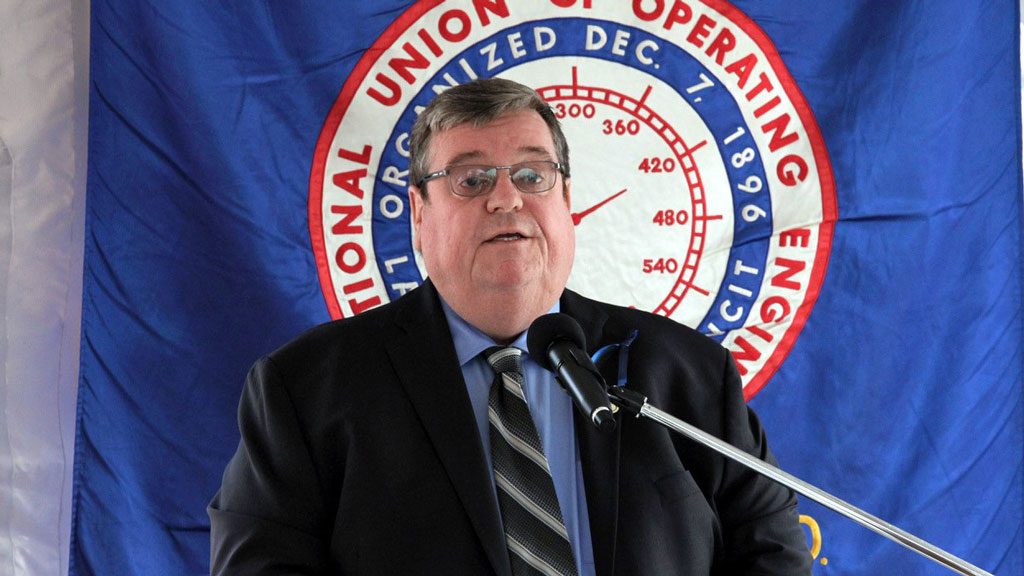Labour, governments and employers must do more to curb fatalities and injuries on construction sites, International Union of Operating Engineers (IUOE) Local 793 business manager Mike Gallagher said in remarks at a Day of Mourning ceremony held the day before the national event on April 27 at the union’s head office in Oakville, Ont.
“The trend this year for fatalities is absolutely going the wrong way,” he said. “That means that we have to redouble our efforts, find out what the main cause is, what’s happening and make sure that we take actions to prevent these fatalities from happening.”
About 100 people, including many employers, apprentices and union staff, attended the ceremony, held at a monument dedicated to Local 793 operators who’ve been killed or injured on the job.
In the audience were a number of family members of Local 793 operators whose names are etched on the monument.
One new name was engraved on the monument this year — that of 54-year-member Wayne McPhail who died from asbestosis on April 6, 2017 at 77. McPhail developed problems from asbestos on the clutches and brakes he worked on.
Gallagher said while efforts are being made to prevent incidents, the fatality statistics so far this year for construction are sobering.
“When we think we’re going in the right direction, we start to go in the wrong direction,” he said.
There have been seven construction fatalities in Ontario so far this year, he said, up from two during the same period in 2017. Last year, he noted, 22 people were killed in construction site incidents in the province, up significantly from 14 in 2016, while 271 construction workers were injured, up from 182 in 2016.
According to the Workplace Safety and Insurance Board (WSIB), about 200 people are killed each year on the job in Ontario.
He said a large number of construction fatalities are either from struck-by incidents or falls.
The law is there but the enforcement of that is not and very few employers have gone to jail
— Mike Gallagher
International Union of Operating Engineers
“You can fall just seven feet and end up in a fatality,” he said. “Some of these falls are from much greater heights and some of them are from lesser, but a fall is absolutely a major problem despite all the efforts that have been made for fall protection and everything else.
“It just seems not to be getting through because you can have fall protection gear on, but if you don’t tie off it isn’t worth anything really except decoration.”
Gallagher noted the Ontario government has launched an awareness program called Stand Down for Safety aimed at encouraging construction employers and workers to engage in toolbox-style talks at the start of each workday to ensure safety is a daily focus.
However, he said, more must be done, legislation needs to be tougher and efforts to prevent fatalities from happening have to move quicker.
Gallagher noted several years ago two young girls were killed in a tragic incident in the Niagara area on a Take Our Kids to Work Day when the “Gator” utility vehicle they were riding in smashed into the bottom of a parked truck-trailer.
“If that doesn’t tell you there’s something wrong with how we view health and safety nothing will,” he said.
He also spoke about a fatality involving Kyle Knox, a Local 793 apprentice who was killed Oct. 11, 2011 when a rotary drill rig collapsed at a construction site in Toronto. The operator of the drill rig was not licensed and only had 80 hours training.
Gallagher said Knox was a young man with a promising career and the incident likely would not have happened if a licensed, qualified operator had been running the rig.
He told those at the ceremony that labour organizations have been pushing for more penalties and bigger fines for employers who are criminally responsible for fatalities since the Westray mine disaster, but the fact is it’s not happening.
“The law is there but the enforcement of that is not and very few employers have gone to jail,” he stated. “The other thing is that the fines, on average, are just under $100,000 across the country for a fatality and I say to you that that’s a pitifully low amount to value a human life when there’s been absolute cause of an employer ignoring health and safety.”
Gallagher said he believes fines have to increase but governments also have to put more money into prevention.
“Everybody talks a good game in government and that probably happens in every province across the country where they talk the mantra, but they don’t necessarily follow through with what they’re saying,” he said.
Gallagher said Ontario has a chief prevention officer but the problem is that everything moves too slowly when it comes to health and safety.
For example, he said, a study done by the Construction Safety Association of Ontario showed compulsory certification of crane operators coupled with mandatory training reduced operator fatalities in Ontario by more than 80 per cent or higher, but crane licensing regulations across the country are less than Ontario’s standard.
As a result of harmonization efforts, he said, there is pressure on Ontario to lower its standards and reduce the amount of training hours required to become a crane operator. Instead, he said, the tide should be reversed and compulsory certification should be made mandatory for every piece of heavy equipment.
Gallagher called on governments to ensure all types of heavy equipment have certified and licensed, mandatory-trained and qualified operators.
IUOE Local 793 president Joe Redshaw, who emceed the ceremony, called on the Ministry of Labour (MOL) to conduct more enforcement blitzes to make sure workers are trained and using equipment properly.
He also called on the WSIB, Infrastructure Health and Safety Association and MOL to review statistics to find out if there’s a common cause for fatalities.
“We need to look at those deeper and find out if we can find a cause and then we can focus on that type of training,” he said.











Recent Comments
comments for this post are closed